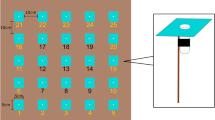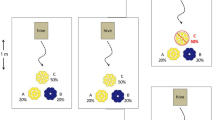Abstract
Volatile odors from flowers play an important role in plant-pollinator interaction. The honeybee is an important generalist pollinator of many plants. Here, we explored whether any components of the odors of a range of honeybee-pollinated plants are commonly involved in the interaction between plants and honeybees. We used a needle trap system to collect floral odors, and GC–MS analysis revealed nonanal was the only component scent detected in 12 different honeybee-pollinated flowers and not present in anemophilous plant species. For Ligustrum compactum, blooming flowers released significantly more nonanal than buds and faded flowers. For Sapium sebiferum, nonanal release through the day correlated with nectar secretion. Experimentally increasing nectar load in flowers of Sapium sebiferum, Ligustrum compactum, and Castanea henryi increased nonanal levels also. Nonanal was also detected in flower nectar and honeys from experimental colonies. Electroantennogram recordings and behavioral observations showed that untrained honeybees could detect and were strongly attracted to nonanal. We argue that nonanal persists in both honey and nectar odors facilitating a learned association between nonanal and food reward in honeybees.





Similar content being viewed by others
References
Abanda-Nkpwatt D, Krimm U, Coiner HA, Schreiber L, Schwab W (2006) Plant volatiles can minimize the growth suppression of epiphytic bacteria by the phytopathogenic fungus Botrytis cinerea in co-culture experiments. Environ Exp Bot 56:108–119. https://doi.org/10.1016/j.envexpbot.2005.01.010
Alissandrakis E, Tarantilis PA, Harizanis PC, Polissiou M (2007) Comparison of the volatile composition in thyme honeys from several origins in Greece. J Agric Food Chem 55:8152–8157. https://doi.org/10.1021/jf071442y
Alissandrakis E, Tarantilis PA, Pappas C, Harizanis PC, Polissiou M (2011) Investigation of organic extractives from unifloral chestnut (Castanea sativa L.) and eucalyptus (Eucalyptus globulus Labill.) honeys and flowers to identification of botanical marker compounds. LWT-Food Sci Technol 44:1051
Andrew SC, Perry CJ, Barron AB, Berthon K, Peralta V, Cheng K (2014) Peak shift in honey bee olfactory learning. Anim Cogn 17:1177–1186. https://doi.org/10.1007/s10071-014-0750-3
Arenas A, Kohlmaier MG (2019) Nectar source profitability influences individual foraging preferences for pollen and pollen-foraging activity of honeybee colonies. Behav Ecol Sociobiol 73:34. https://doi.org/10.1007/s00114-006-0176-0
Balao F, Herrera J, Talavera S, Dotterl S (2011) Spatial and temporal patterns of floral scent emission in Dianthus inoxianus and electroantennographic responses of its hawkmoth pollinator. Phytochem 72:601–609. https://doi.org/10.1016/j.phytochem.2011.02.001
Baldwin IT (2010) Plant volatiles. Curr Biol 20:392–397. https://doi.org/10.1016/j.cub.2010.02.052
Bayraktar D, Ur TAO (2011) Investigation of the aroma impact volatiles in Turkish pine honey samples produced in Marmaris, Data and Fethiye regions by SPME/GC/MS technique. Int J Food Sci Tech 46:1060–1065. https://doi.org/10.1111/j.1365-2621.2011.02588.x
Belsare PV, Sriram B, Watve MG (2009) The co-optimization of floral display and nectar reward. J Biosci 34:963–967. https://doi.org/10.1007/s12038-009-0110-7
Bhagavan S, Smith BH (1997) Olfactory conditioning in the honey bee, Apis mellifera: effects of odor intensity. Physiol Behav 61:1–117. https://doi.org/10.1016/s0031-9384(96)00357-5
Bianchi F, Mangia A, Mattarozzi M, Musci M (2011) Characterization of the volatile profile of thistle honey using headspace solid-phase microextraction and gas chromatography–mass spectrometry. Food Chem 129:1030–1036. https://doi.org/10.1016/j.foodchem.2011.05.070
Brockmann A, Brückner D, Crewe RM (1998) The EAG response spectra of workers and drones to queen honeybee mandibular gland components: the evolution of a social signal. Naturwissenschaften 85:283–285. https://doi.org/10.1007/s001140050500
Chapurlat E, Ågren J, Anderson J, Friberg M, Sletvold N (2019) Conflicting selection on floral scent emission in the orchid Gymnadenia conopsea. New phytologist 222:2009–2022. https://doi.org/10.1111/nph.15747
Chittka L, Raine NE (2006) Recognition of flowers by pollinators. Curr Opin Plant Biol 9:428–435. https://doi.org/10.1016/j.pbi.2006.05.002
Daisey JM, Hopke PK (1991) Potential for ion-induced nucleation of volatile organic compounds by radon decay in indoor environments. Aerosol Sci Tech 19:80–93. https://doi.org/10.1080/02786829308959623
Daumer K (1956) Reizmetrische Untersuchung des Farbensehens der Bienen. Z Vgl Physiol 38:413–478. https://doi.org/10.1007/BF00340456
Daumer K (1958) Blumenfarben, wie sie die Bienen sehen. Z Vgl Physiol 41:49–110. https://doi.org/10.1007/BF00340242
Eisenhardt D (2014) Molecular mechanisms underlying formation of long-term reward memories and extinction memories in the honeybee (Apis mellifera). Learn Memory 21:534–542. https://doi.org/10.1101/lm.033118.113
Farina WM, Gruter C, Acosta L, Mc CS (2007) Honeybees learn floral odors while receiving nectar from foragers within the hive. Naturwissenschaften 94:55–60. https://doi.org/10.1007/s00114-006-0157-3
Galán RF, Weidert M, Menzel R, Herz AV, Galizia CG (2014) Sensory memory for odors is encoded in spontaneous correlated activity between olfactory glomeruli. Neural Comput 18:10–25. https://doi.org/10.1162/089976606774841558
Galizia CG, Sachse S, Rappert A, Menzel R (1999) The glomerular code for odor representation is species specific in the honeybee Apis mellifera. Nat Neurosci 2:473–478. https://doi.org/10.1038/8144
Glaettli M, Barrett SC (2008) Pollinator responses to variation in floral display and flower size in dioecious Sagittaria latifolia (Alismataceae). New Phytol 179:1193–1201. https://doi.org/10.1111/j.1469-8137.2008.02532.x
He XJ, Zhang XC, Jiang WJ, Barron AB, Zhang JH, Zeng ZJ (2016) Starving honey bee (Apis mellifera) larvae signal pheromonally to worker bees. Sci Rep 6:22359. https://doi.org/10.1038/srep22359
Hourcade B, Perisse E, Devaud JM, Sandoz JC (2009) Long-term memory shapes the primary olfactory center of an insect brain. Learn Memory 16:607–615. https://doi.org/10.1101/lm.1445609
Iwashita G, Hibino T (2011) Assessment on odor intensity of bioeffluents by VOC concentration perceived air pollution caused by human bioeffluents (part 2). J Environ Eng AIJ 76:539–545. https://doi.org/10.3130/aije.76.539
Iwashita G, Tokunaga N (2012) Discussion on the index of body odor pollution based on VOC concentration in classrooms perceived air pollution caused by human Bioeffluents (part 3). J Environ Eng AIJ 77:65–70. https://doi.org/10.3130/aije.77.65
Jerkovi I, Tuberoso CIG, Marijanovi Z, Jeli M, Kasum A (2009) Headspace, volatile and semi-volatile patterns of Paliurus spina-christi unifloral honey as markers of botanical origin. Food Chem 112:239–245. https://doi.org/10.1016/j.foodchem.2008.05.080
Joerges J, Küttner A, Galizia CG, Menzel R (1997) Representations of odours and odour mixtures visualized in the honeybee brain. Nature 387:285–287. https://doi.org/10.1038/387285a0
Jorgensen U, Hansen M, Christensen LP, Jensen K, Kaack K (2000) Olfactory and quantitative analysis of aroma compounds in elder flower (Sambucus nigra L.) drink processed from five cultivars. J Agric Food Chem 48:2376–2383. https://doi.org/10.1021/jf000005f
Kaškonienė V, Ruočkuvienė G, Kaškonas P, Akuneca I, Maruška A (2015) Chemometric analysis of bee pollen based on volatile and phenolic compound compositions and antioxidant properties. Food Anal Method 8:1150–1163. https://doi.org/10.1007/s12161-014-9996-2
Kiester AR, Lande R, Schemske D (1984) Models of coevolution and speciation in plants and their pollinators. Am Nat 2:220–243. https://doi.org/10.1086/284265
Klein AM, Vaissiere BE, Cane JH, Steffan-Dewenter I, Cunningham SA, Kremen C, Tscharntke T (2007) Importance of pollinators in changing landscapes for world crops. Proc Biol Sci 274:303–313. https://doi.org/10.1098/rspb.2006.3721
Knauer AC, Schiestl FP (2015) Bees use honest floral signals as indicators of reward when visiting flowers. Ecol Lett 18:135–143. https://doi.org/10.1111/ele.12386
Komischke B, Giurfa M, Lachnit H, Malun D (2002) Successive olfactory reversal learning in honeybees. Learn Memory 9:122. https://doi.org/10.1101/lm.44602
Krishna S, Keasar T (2018) Morphological Complexity as a Floral Signal: From Perception by Insect Pollinators to Co-Evolutionary Implications. Int J Mol Sci 19:1681. https://doi.org/10.3390/ijms19061681
Laska M, Galizia CG, Giurfa M, Menzel R (1999) Olfactory discrimination ability and odor structure-activity relationships in honeybees. Chem Senses 24:429–438. https://doi.org/10.1093/chemse/24.4.429
Leonard AS, Dornhaus A, Papaj DR (2010) Flowers help bees cope with uncertainty: signal detection and the function of floral complexity. J Exp Biol 214:113–121. https://doi.org/10.1242/jeb.047407
Liu JH, Liu W, Qing ZX, Zeng ZY, Zhong XH, Zeng JG (2020) Analysis of volatile compositions in different flower parts of two varieties of Hemerocallis citrina Baroni by HS-SPME-GC-MS. Nat Prod Res Dev 32:269–377, 304 (in Chinese). https://doi.org/10.16333/j.1001-6880.2020.2.011
Luo C, Huang ZY, Li K, Chen X, Chen Y, Sun Y (2013) EAG responses of Apis cerana to floral compounds of a biodiesel plant, Jatropha curcas (Euphorbiaceae). J Econ Entomol 106:1653–1658. https://doi.org/10.1603/EC12458
Menzel R, Muller U (1995) Learning and memory in honeybees: from behavior to neural substrates. Annual Annu Rev Neurosci 19:379–404. https://doi.org/10.1146/annurev.ne.19.030196.002115
Moyroud E, Wenzel T, Middleton R, Rudall PJ, Banks H, Reed A, Mellers G, Killoran P, Westwood MM, Steiner U, Vignolini S, Glover BJ (2017) Disorder in convergent floral nanostructures enhances signalling to bees. Nature 550:469–474. https://doi.org/10.1038/nature24285
Müller U (2002) Learning in honeybees: from molecules to behaviour. Zoology 105:313–320. https://doi.org/10.1078/0944-2006-00075
Naef R, Jaquier A, Velluz A, Bachofen B (2004) From the linden flower to linden honey-volatile constituents of linden nectar, the extract of bee-stomach and ripe honey. Chem Biodivers 1:1870–1879. https://doi.org/10.1002/cbdv.200490143
Pauw A, Stofberg J, Waterman RJ (2009) Flies and flowers in Darwin’s race. Evolution 63:268–279. https://doi.org/10.1111/j.1558-5646.2008.00547.x
Rodriguez-Girones MA, Santamaria L (2005) Resource partitioning among flower visitors and evolution of nectar concealment in multi-species communities. Proc Biol Sci 272:187–192. https://doi.org/10.1098/rspb.2005.2936
Rodriguez-Girones MA, Santamaria L (2006) Models of optimum foraging and resource partitioning: deep corollas for long tongues. Behav Eco 17:905–910. https://doi.org/10.1093/beheco/arl024
Seeley TD (1985) Honeybee Ecology: A Study of Adaptation in Social Life. Princeton University Press, New Jersey
Schade F, Legge RL, Thompson JE (2001) Fragrance volatiles of developing and senescing carnation flowers. Phytochemistry 56:703–710. https://doi.org/10.1016/S0031-9422(00)00483-0
Scheiner R, Schnitt S, Erber J (2005) The functions of antennal mechanoreceptors and antennal joints in tactile discrimination of the honeybee (Apis mellifera L.). J Comp Physiol A Neuroethol 191:857–864. https://doi.org/10.1007/s00359-005-0009-1
Schiestl FP (2010) The evolution of floral scent and insect chemical communication. Ecol Lett 13:643–656. https://doi.org/10.1111/j.1461-0248.2010.01451.x
Twidle AM, Barker D, Seal AG, Fedrizzi B, Suckling DM (2018) Identification of Floral Volatiles and Pollinator Responses in Kiwifruit Cultivars, Actinidia chinensis var. chinensis. J Chem Ecol 44:406–415. https://doi.org/10.1007/s10886-018-0936-2
Uzun Y, Dalar A, Konczak L (2017) Sempervivum davisii: phytochemical composition, antioxidant and lipase-inhibitory activities. Pharm Biol 55:532–540. https://doi.org/10.1080/13880209.2016.1255979
Wright GA, Skinner BD, Smith BH (2002) Ability of honeybee, Apis mellifera, to detect and discriminate odors of varieties of canola (Brassica rapa and Brassica napus) and snapdragon flowers (Antirrhinum majus). J Chem Ecol 28:721–740. https://doi.org/10.1023/a:1015232608858
Wright GA, Carlton M, Smith BH (2009) A honeybee’s ability to learn, recognize, and discriminate odors depends upon odor sampling time and concentration. Behav Neurosci 123:36–43. https://doi.org/10.1037/a0014040
Wright GA, Schiestl FP (2009) The evolution of floral scent: the influence of olfactory learning by insect pollinators on the honest signalling of floral rewards. Funct Ecol 23:841–851. https://doi.org/10.1111/j.1365-2435.2009.01627.x
Wu Q, Ling J, Xu Y (2014) Starter culture selection for making Chinese sesame-flavored liquor based on microbial metabolic activity in mixed-culture fermentation. Appl Environ Microb 80:4450–4459. https://doi.org/10.1128/AEM.00905-14
Xu WL (1992) Nectar and pollen plants of China. Heilongjiang Science and Technology Press, Harbin
Zhang FP, Larson-Rabin Z, Li DZ, Wang H (2012) Colored nectar as an honest signal in plant-animal interactions. Plant Signal Behav 7:811–812. https://doi.org/10.4161/psb.20645
Acknowledgements
We thank Dr. Guangli Wang for suggesting on EAG experimental design, Dr. Shengliang Liao for help in GC-MS experiments, and Dr. Xinjian Xu for help in floral scent collection.
Funding
This work was supported by the National Natural Science Foundation of China (no. 31702193), Natural Science Foundation of Jiangxi province (no. 20171BAB214018), Key Research and Development Project of Jiangxi province (no. 20181BBF60019), and the Earmarked Fund for China Agriculture Research System (no. CARS-44-KXJ15).
Author information
Authors and Affiliations
Contributions
XJH and ZJZ designed the experiments; YBL and XJH conducted the experiments; YM, YZH, JFL, ZL, and WYY helped in performing the experiments; XJH, YBL, ABB, and ZJZ wrote and revised the paper.
Corresponding author
Ethics declarations
Ethics approval
The study was performed in accordance with the relevant legal requirements in China.
Conflict of interest
The authors declare no competing interests.
Additional information
Communicated by John A. Byers
Publisher's Note
Springer Nature remains neutral with regard to jurisdictional claims in published maps and institutional affiliations.
Rights and permissions
About this article
Cite this article
Liu, Y.B., Zeng, Z.J., Barron, A.B. et al. The involvement of a floral scent in plant-honeybee interaction. Sci Nat 109, 30 (2022). https://doi.org/10.1007/s00114-022-01802-z
Received:
Revised:
Accepted:
Published:
DOI: https://doi.org/10.1007/s00114-022-01802-z






